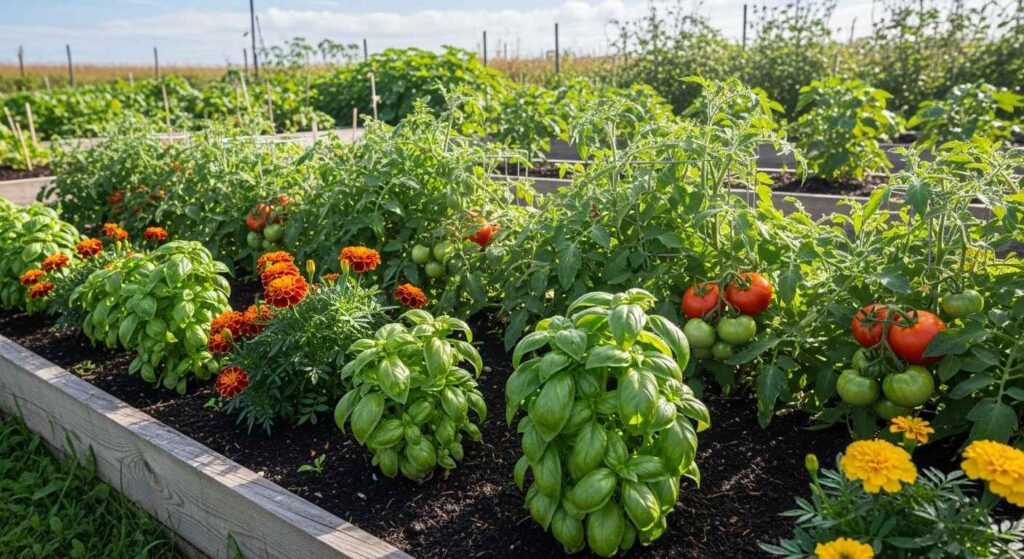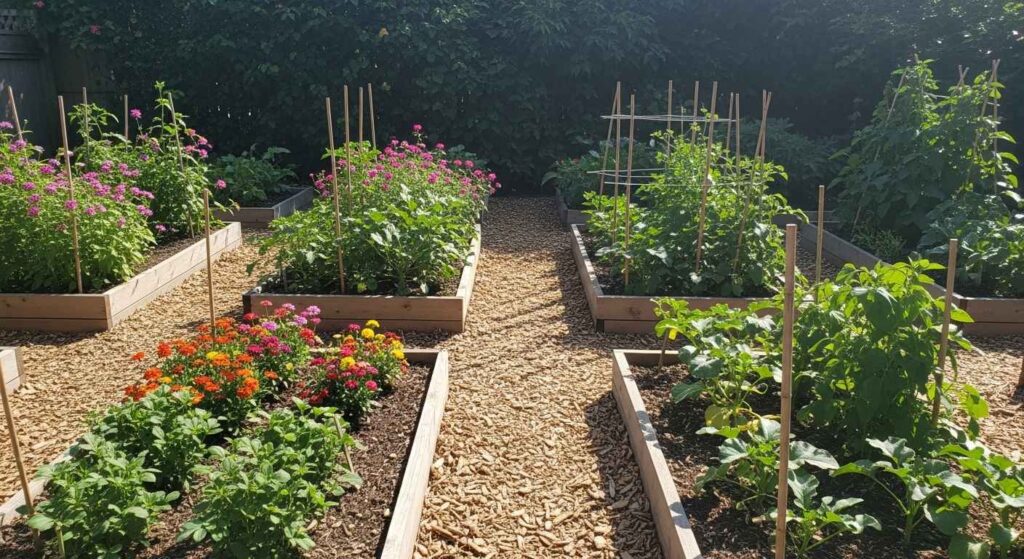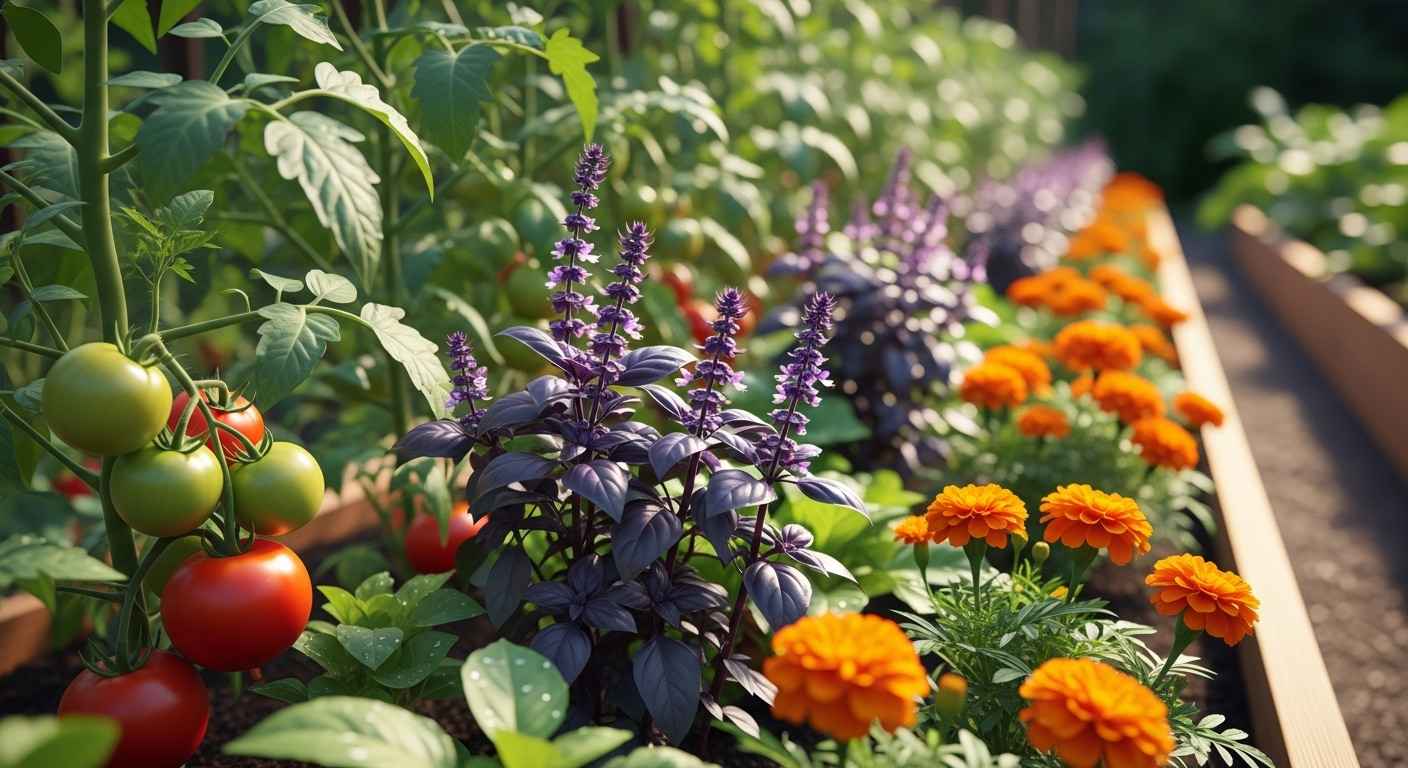Companion planting pairs plants that help each other grow. This method boosts garden health, cuts down on pests, and improves soil. Many gardeners use it for better yields.
What Is Companion Planting?
Companion planting means placing certain plants close together. These plants support one another. Some draw in good bugs. Others keep bad bugs away. Roots from different plants pull nutrients from various soil depths, sharing resources well.
One old example is the Three Sisters. Native Americans planted corn, beans, and squash together. Corn gives beans a pole to climb. Beans add nitrogen to the soil. Squash covers the ground to block weeds. This practice fits small home gardens, using space wisely. You can mix vegetables, herbs, and flowers.
Benefits of Companion Planting
Companion planting offers clear gains. It lowers pest problems without sprays. Plants like marigolds send out smells that confuse insects. Good bugs, such as ladybugs, come to eat aphids. It builds better soil. Legumes like beans fix nitrogen, feeding nearby plants. Diverse roots loosen dirt and add organic matter. Weeds stay down. Low-growing plants shade the soil, stopping weed seeds from sprouting. Yields go up. Pollinators visit more often. Bees like flowers near veggies, leading to more fruit. Space works harder. Tall plants shade short ones, and vines climb on sturdy stems.
Common Companion Planting Pairs
Group plants by what they need. Match sun lovers together. Pair deep roots with shallow ones.
Vegetables and Their Helpers
- Tomatoes: Plant with basil to ward off hornworms. Marigolds cut down on nematodes. Avoid potatoes; they share diseases.
- Carrots: Onions keep carrot flies away. Leeks work too. Skip dill; it draws the wrong bugs.
- Cucumbers: Beans add nitrogen. Nasturtiums trap aphids. Do not plant near potatoes.
- Peppers: Basil fights aphids. Spinach shades the soil. Keep away from fennel.
- Beans: Corn supports climbing types. Potatoes gain from beans’ nitrogen. Avoid onions or garlic.
Use this list for starters. Test pairs in your yard.
Herbs as Companions
Herbs fit well in veggie beds. Basil helps tomatoes taste better. Dill draws ladybugs. Mint repels ants but spreads fast; pot it. Plant chives near carrots to deter flies. Sage protects cabbage from moths.
Flowers for Support
Flowers bring color and aid. Marigolds guard roots from worms. Sunflowers offer shade and draw birds that eat bugs. Nasturtiums lure pests from veggies, acting as traps. Zinnias pull in bees for pollination.
Plants to Avoid Planting Together
Some plants harm each other. They fight for food or spread sickness.
- Onions and beans: Onions slow bean growth.
- Fennel and most veggies: Fennel hurts nearby plants.
- Potatoes and tomatoes: Both get blight easily.
- Cucumbers and sage: Sage stunts cucumbers.
Check your garden plan. Space bad pairs far apart.
How to Start Companion Planting
Plan your beds first. Draw a map. Note sun, soil, and water needs. Start small. Pick two or three pairs. Watch how they grow. Rotate crops each year to stop soil loss and pest buildup. Add mulch to hold water and cut weeds. Water at the base; wet leaves spread disease.
Companion Planting Chart
Use this chart for quick picks. It shows good and bad matches.
| Vegetable | Good Companions | Bad Companions |
|---|---|---|
| Tomatoes | Basil, marigolds, carrots | Potatoes, fennel |
| Carrots | Onions, leeks, tomatoes | Dill, parsnips |
| Cucumbers | Beans, nasturtiums, radishes | Potatoes, sage |
| Peppers | Basil, spinach, onions | Fennel, beans |
| Beans | Corn, potatoes, squash | Onions, garlic |
| Cabbage | Sage, dill, beets | Strawberries, tomatoes |
| Squash | Corn, beans, nasturtiums | Potatoes, pumpkins |
Print this for your shed.

Tips for Success in Your Yard
Test soil pH; most veggies like 6.0 to 7.0. Watch for signs like yellow leaves, which mean nutrient lack. Harvest often to keep plants producing. Mix in native plants to draw local pollinators. Link to related reads on our site for more garden help: See our guide on low-light plants that thrive in dark rooms for indoor ideas, winter plant care tips for indoor houseplants to keep greens year-round, or how to create a drought-resistant lawn that stays green all summer for lawn ties. For more facts, visit the University of Minnesota Extension on companion planting.

Answers to Common Questions
What rules guide companion planting? Pair plants with like needs. Use smells for pest control.
Give an example. Plant carrots with onions to repel flies.
Which three plants grow best together? Corn, beans, squash.
What boosts pollination? Add flowers like zinnias near veggies.
How does it help small spaces? Layers plants by height.
This guide gives you tools to try companion planting. Your garden will thank you.
